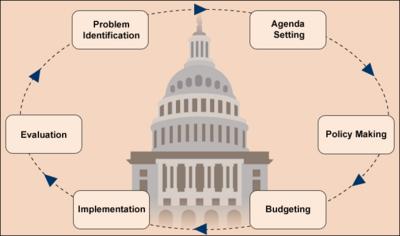
The public policy process is a multi-stage cycle.
These six stages overlap each other, with additional mini-stages, in a process that never really ends.
1. Problem Identification
Either public opinion or elite opinion expresses dissatisfaction with a status quo policy. The problem is defined and articulated by individuals and institutions such as mass media, interest groups, and parties.
2. Agenda Setting
The definition of alternatives is crucial to the policy process and outcomes. Before a policy can be formulated and adopted, the issue must compete for space on the agenda (list of items being actively considered). An idea must make it through several levels, including the broad political system agenda, the congressional and presidential agendas, and the bureaucratic agenda. Key actors in agenda setting include think tanks, interest groups, media, and government officials.
3. Policy Making
From the problems that have been identified and have made it onto the various agendas, policies must be formulated to address the problems. Those policy formulations then must be adopted (authorized) through the congressional process and refined through the bureaucratic process. Of course, a non-decision (inaction, or defeating a proposal) is, itself, policy making.
4. Budgeting
Each year, Congress must decide through the appropriations process how much money to spend on each policy. Generally, a policy must first be authorized (adopted) before money can be appropriated for it in the annual budget.
5. Implementation
Executive agencies (the bureaucracy) carry out, or implement, policy. Implementation could include adopting rules and regulations, providing services and products, public education campaigns, adjudication of disputes, etc.
6. Evaluation
Numerous actors evaluate the impact of policies, to see if they are solving the problems identified and accomplishing their goals. Evaluation looks at costs and benefits of policies as well as their indirect and unintended effects. Congress uses its oversight function and the General Accounting Office for evaluation, agencies evaluate their own performance, and outside evaluators include interest groups, think tanks, academia, and media. Evaluation frequently triggers identification of problems and a new round of agenda setting and policy making.